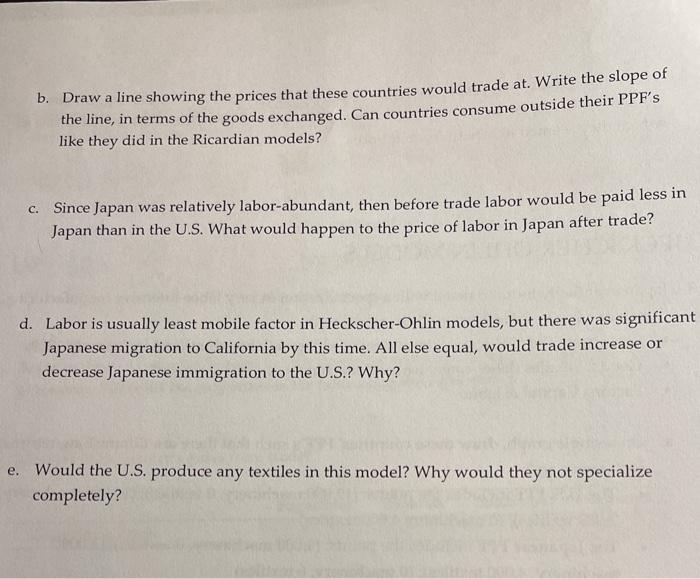please help expalin this is just a review but its been 3 years since ive done this stuff

HECKSCHER-OHLIN MODELS 3. Japan eventually industrialized with a specialization in very labor-intensive manufacturing, Consider a 2 x 2 x 2 Heckscher-Ohlin model with: Countries: The U.S. (capital abundant) and Japan (labor abundant) in the early 1900s Goods: Textiles (labor-intensive) and machinery (capital-intensive) Factors: Capital & labor . . . a. On a single graph, draw these countries' PPF's such that there are diminishing returns to each factor and: The U.S. PPF includes the points: (12,000 machinery, 0 textiles); (10,000 machinery, 2,000 textiles): (O machinery 4,000 textiles) The Japanese PPF includes the points: (4,000 machinery, 0 textiles); (3,000 machinery, 4,000 textiles); (O machinery; 6 textiles) . Machinery (1,000s, Capital intensive) Textiles (1,000s, Labor intensive) b. Draw a line showing the prices that these countries would trade at. Write the slope of the line, in terms of the goods exchanged. Can countries consume outside their PPF's like they did in the Ricardian models? c. Since Japan was relatively labor-abundant, then before trade labor would be paid less in Japan than in the U.S. What would happen to the price of labor in Japan after trade? d. Labor is usually least mobile factor in Heckscher-Ohlin models, but there was significant Japanese migration to California by this time. All else equal, would trade increase or decrease Japanese immigration to the U.S.? Why? e. Would the U.S. produce any textiles in this model? Why would they not specialize completely? HECKSCHER-OHLIN MODELS 3. Japan eventually industrialized with a specialization in very labor-intensive manufacturing, Consider a 2 x 2 x 2 Heckscher-Ohlin model with: Countries: The U.S. (capital abundant) and Japan (labor abundant) in the early 1900s Goods: Textiles (labor-intensive) and machinery (capital-intensive) Factors: Capital & labor . . . a. On a single graph, draw these countries' PPF's such that there are diminishing returns to each factor and: The U.S. PPF includes the points: (12,000 machinery, 0 textiles); (10,000 machinery, 2,000 textiles): (O machinery 4,000 textiles) The Japanese PPF includes the points: (4,000 machinery, 0 textiles); (3,000 machinery, 4,000 textiles); (O machinery; 6 textiles) . Machinery (1,000s, Capital intensive) Textiles (1,000s, Labor intensive) b. Draw a line showing the prices that these countries would trade at. Write the slope of the line, in terms of the goods exchanged. Can countries consume outside their PPF's like they did in the Ricardian models? c. Since Japan was relatively labor-abundant, then before trade labor would be paid less in Japan than in the U.S. What would happen to the price of labor in Japan after trade? d. Labor is usually least mobile factor in Heckscher-Ohlin models, but there was significant Japanese migration to California by this time. All else equal, would trade increase or decrease Japanese immigration to the U.S.? Why? e. Would the U.S. produce any textiles in this model? Why would they not specialize completely









